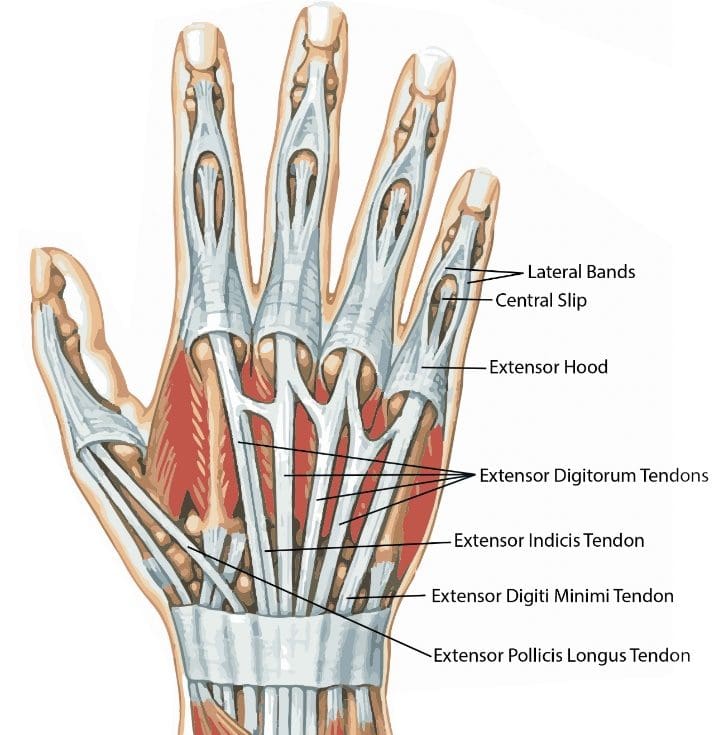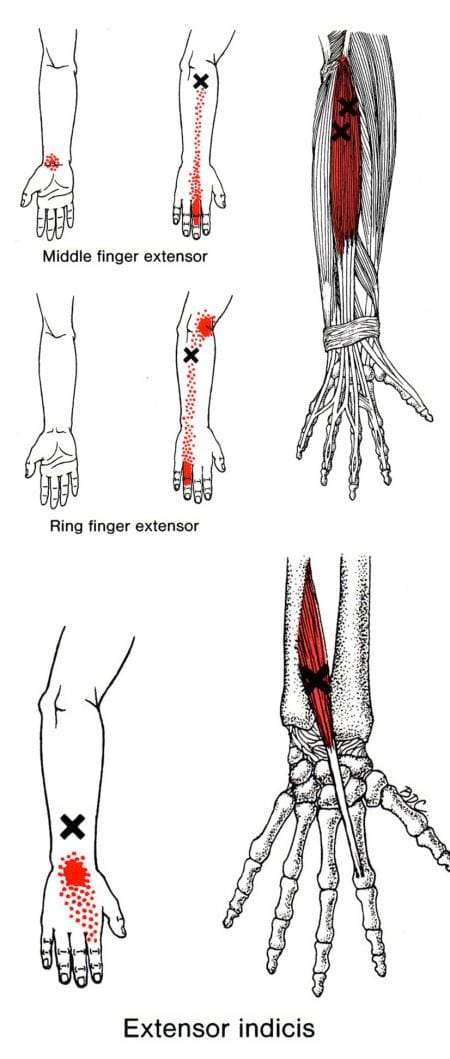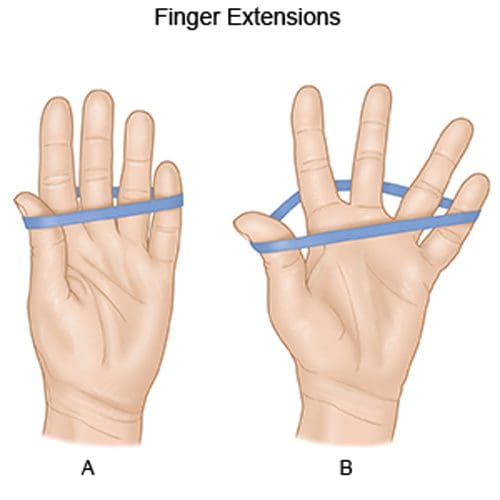Table of Contents
Introduction
The fingers are in a close relationship with the hands and the body. Each finger digit is controlled by various muscles encompassing the wrist and forearms. The fingers allow the host to be expressive and point and manipulate objects while protecting the joints in each digit. When chronic conditions or injuries begin to affect each finger digit, it can lead to referred pain along the hand muscles, the wrists, and the forearms, causing the development of trigger points to overlap the affected muscles in the fingers. Today’s article looks at how the finger extensor muscles work, how trigger points affect the finger extensor muscles, and how to manage pain associated with trigger points along the fingers. We refer patients to certified providers who specialize in hand pain treatments to aid individuals suffering from trigger points related to pain affecting the finger extensor muscles along the hands. We also guide and inform our patients by referring them to our associated medical providers based on their examination when appropriate. We established that education is a great solution to asking our providers profound questions the patient requests. Dr. Jimenez DC takes note of this information as an educational service only. Disclaimer
How Do The Finger Extensor Muscles Work?

Are you experiencing pain in your fingers? Does it seem difficult to hold onto items even for a short period? Or are you experiencing muscle pain from your thumb to your wrist? Numerous individuals experiencing pain in their fingers and hands risk developing trigger points or myofascial pain syndrome in their fingers and hands. The hand muscles have many intricated muscles and insert themselves as the origin points for the bones, ligaments, and fascia of the hands. The finger extensor muscles begin at the forearms as the point of origin and stretch past the wrist to each finger digit which includes:
- Thumb
- Index finger
- Middle finger
- Ring finger
- Pinky finger
The three main fingers that provide motion for the hands are the index, ring, and middle finger, which allow the muscles to be held in flexion and extension while giving extra support for hand actions for gripping items. Studies reveal that even though the structural and functional complexities of the human fingers have been recognized, each finger recognized an effective function of precise coordination of multiple muscles. To that point, this results in constrained finger motion by exerted forces from the joint capsules, ligaments, and joint articular surfaces. However, the tendons and the extensor muscles of the fingers suffer from injuries and conditions that can affect the functionality of each finger’s grip strength.
How Trigger Points Affect The Finger Extensor Muscles?
When the hands, wrists, and forearms are injured from traumatic forces or through ordinary factors like pulling a muscle or feeling unexplainable pain in the forearms, it can lead to referred pain along the affected muscles. This then leads to the development of trigger points along the affected muscles affecting mobility function with the fingers. According to Dr. Travell, M.D., when patients complain about pain in their hands, they often identify it with arthritis on the fingers when it is caused by trigger points affecting the extensor muscles in the fingers. Studies reveal that trigger points along the finger extensor muscles could refer to mechanical impingement of the tendon being narrowed through repetitive movements. When this happens, it can lead to inflammation and resistance of the tendon, causing the finger digit to lock up in a flex pose. Sometimes trigger points can even inhibit muscular contraction without pain, causing symptoms of grip weakness on the fingers. When trigger points affect the extensor muscles of the fingers and hands, it can make many individuals feel frustrated that they cannot hold onto items while doing their daily activities.

Trigger Points On The Extensor Digitorum-Video
Are you noticing that your grip strength has weakened? Do you feel pain starting from your forearm and ending at your fingertips? Or do your fingers lock up from time to time? Many of these symptoms affecting the fingers could develop signs of trigger points affecting the finger extensor muscles, causing hand pain. Trigger points usually form when the muscle from each section of the body has been through trauma, injuries, or overuse. To that point, the affected muscle has small knots along the muscle fibers, thus causing referred pain in the affected area. The video above explains where the extensor muscles are located in the forearm and how they branch out to each finger digit. When trigger points affect the muscle fibers of the extensor muscles, it can lead to hyperirritability of the muscle fibers and invoke referred pain in the surrounding tendons. Studies reveal that factors that pertain to overusing the fingers may be due to work-related musculoskeletal disorders, which lead to the association with intracellular compartmentation during non-invasive activities. This shows that latent trigger points may potentially occur on the affected muscle with or without pain.
Managing Pain Associated With Trigger Points On The Fingers

When it comes to managing trigger points along the extensor fingers, there are various techniques that many people can use to relieve pain in their hands, strengthen their grip strength, and prevent future trigger points from forming along the forearms. When many people go to their primary physicians and complain about losing their grip strength or feeling symptoms of inflammation associated with arthritis, their doctors begin to do a full examination. They communicate with them about what they have been doing with their hands. Once the doctors have a full diagnosis, they will begin to advise their patients on various techniques to relieve pain in their hands and strengthen their fingers. Some of the ways to manage trigger points along the fingers include:
- Hand stretches to relieve stress on the finger joints
- Finger extension extends with a rubber band
- Avoid gripping items tightly
- Sleep with fingers in a flex position
- Use an ice pack to reduce inflammation in the forearm muscles
Incorporating these various techniques can reduce pain-like symptoms along the forearms, wrists, and hands and help manage trigger points from causing more issues on the hands. These techniques allow the finger extensor muscles to regain their strength and enable the individual to restore grip strength.
Conclusion
The fingers provide a close working relationship with the hands and body. The fingers allow motions expressively with the host and provide flexion and extension to each digit through extensor muscles that are located in the forearms. When injuries or hyperextension issues affect the extensor muscle, it can develop trigger points that can affect grip strength on the hands and cause pain along the finger digits and wrist. This can cause misery to the individual. Fortunately, various techniques reduce the pain in the hands and increase grip strength on the fingers while managing trigger points associated with the extensor muscles. When individuals begin to utilize stretches for their hands and wrists, it allows them to have finger mobility back to their hands and reduces the effects of pain along their forearms.
References
Ali, Stephen R, and Hussein Mohamedbahi. “Acute Trigger Finger Presenting as an Extensor Lag.” Eplasty, Open Science Company, LLC, 5 Jan. 2018, www.ncbi.nlm.nih.gov/pmc/articles/PMC5765627/.
Hu, Dan, et al. “Biomechanical Analysis of the Human Finger Extensor Mechanism during Isometric Pressing.” PloS One, Public Library of Science, 14 Apr. 2014, www.ncbi.nlm.nih.gov/pmc/articles/PMC3986208/.
Moreno-Torres, Angel, et al. “Work-Related Pain in Extrinsic Finger Extensor Musculature of Instrumentalists Is Associated with Intracellular Ph Compartmentation during Exercise.” PloS One, Public Library of Science, 9 Feb. 2010, www.ncbi.nlm.nih.gov/pmc/articles/PMC2817730/.
Okwumabua, Ebubechi, et al. “Anatomy, Shoulder and Upper Limb, Hand Muscles.” In: StatPearls [Internet]. Treasure Island (FL), StatPearls Publishing, 31 July 2021, www.ncbi.nlm.nih.gov/books/NBK537229/.
Disclaimer
Post Disclaimer
Professional Scope of Practice *
The information herein on "Trigger Points Affecting The Fingers" is not intended to replace a one-on-one relationship with a qualified health care professional or licensed physician and is not medical advice. We encourage you to make healthcare decisions based on your research and partnership with a qualified healthcare professional.
Blog Information & Scope Discussions
Welcome to El Paso's Wellness blog, where Dr. Alex Jimenez, DC, FNP-C, a board-certified Family Practice Nurse Practitioner (FNP-C) and Chiropractor (DC), presents insights on how our team is dedicated to holistic healing and personalized care. Our practice aligns with evidence-based treatment protocols inspired by integrative medicine principles, similar to those found on dralexjimenez.com, focusing on restoring health naturally for patients of all ages.
Our areas of chiropractic practice include Wellness & Nutrition, Chronic Pain, Personal Injury, Auto Accident Care, Work Injuries, Back Injury, Low Back Pain, Neck Pain, Migraine Headaches, Sports Injuries, Severe Sciatica, Scoliosis, Complex Herniated Discs, Fibromyalgia, Chronic Pain, Complex Injuries, Stress Management, Functional Medicine Treatments, and in-scope care protocols.
Our information scope is limited to chiropractic, musculoskeletal, physical medicine, wellness, contributing etiological viscerosomatic disturbances within clinical presentations, associated somato-visceral reflex clinical dynamics, subluxation complexes, sensitive health issues, and functional medicine articles, topics, and discussions.
We provide and present clinical collaboration with specialists from various disciplines. Each specialist is governed by their professional scope of practice and their jurisdiction of licensure. We use functional health & wellness protocols to treat and support care for the injuries or disorders of the musculoskeletal system.
Our videos, posts, topics, subjects, and insights cover clinical matters, issues, and topics that relate to and directly or indirectly support our clinical scope of practice.*
Our office has reasonably attempted to provide supportive citations and has identified the relevant research studies or studies supporting our posts. We provide copies of supporting research studies available to regulatory boards and the public upon request.
We understand that we cover matters that require an additional explanation of how they may assist in a particular care plan or treatment protocol; therefore, to discuss the subject matter above further, please feel free to ask Dr. Alex Jimenez, DC, APRN, FNP-BC, or contact us at 915-850-0900.
We are here to help you and your family.
Blessings
Dr. Alex Jimenez DC, MSACP, APRN, FNP-BC*, CCST, IFMCP, CFMP, ATN
email: coach@elpasofunctionalmedicine.com
Licensed as a Doctor of Chiropractic (DC) in Texas & New Mexico*
Texas DC License # TX5807
New Mexico DC License # NM-DC2182
Licensed as a Registered Nurse (RN*) in Texas & Multistate
Texas RN License # 1191402
ANCC FNP-BC: Board Certified Nurse Practitioner*
Compact Status: Multi-State License: Authorized to Practice in 40 States*
Graduate with Honors: ICHS: MSN-FNP (Family Nurse Practitioner Program)
Degree Granted. Master's in Family Practice MSN Diploma (Cum Laude)
Dr. Alex Jimenez, DC, APRN, FNP-BC*, CFMP, IFMCP, ATN, CCST
My Digital Business Card


